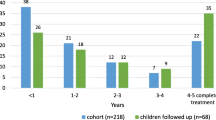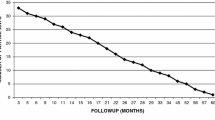Abstract
In 2001, Roye et al. developed a disease-specific instrument (DSI) to measure outcomes of treatment for clubfoot. We assessed this instrument using a cohort of 62 patients, ages 5 through 12 years (mean, 8.6 years), with idiopathic clubfoot who were treated as infants by various methods. Treatment groups were defined by whether the patient received joint-invasive surgery (posterior or posteromedial release surgery) or joint-sparing treatment only (manipulation and casting with or without tendo-Achilles lengthening or anterior tibial tendon transfer). The DSI scales demonstrated internal consistency reliability of 0.74 to 0.85 using Cronbach’s alpha. Higher (better) DSI scores were associated with “excellent” general health ratings and better health-related quality of life; lower DSI score were related to special healthcare needs. Patients treated using joint-sparing techniques only (eg, Ponseti technique) had higher DSI scores than those who had received joint-invasive surgery. DSI scores for patients who had received posterior or posterior medial release surgery were very similar to those reported by Roye et al. in New York for a comparable group of patients. Our findings suggest the DSI is sensitive to differences in treatment technique or underlying severity of disease. These data support the use of the Roye DSI as an outcome measure for idiopathic clubfoot in children.
Level of Evidence: Level III, diagnostic study. See the Guidelines for Authors for a complete description of levels of evidence.
Similar content being viewed by others
References
Bethell CD, Read D, Stein RE, Blumberg SJ, Wells N, Newacheck PW. Identifying children with special health care needs: development and evaluation of a short screening instrument. Ambul Pediatr. 2002;2:38–48.
Children or Youth with Special Health Care Needs (CYSHCN). Child and Adolescent health measurement initiative [CAHMI] Children with Special Health Care Needs Screening Instrument. Available at http://www.cahmi.org/pages/Topics.aspx?section=10&topic=66. Accessed on December 1, 2008.
Dyer PJ, Davis N. The role of the Pirani scoring system in the management of club foot by the Ponseti method. J Bone Joint Surg Br. 2006;88:1082–1084.
Foundation for Accountability (FACCT) CSHCN module. Available at: http://dch.ohsuhealth.com//index.cfm?cfid=6&cftoken=59572841&pageid=458§ionID=133. Accessed August 2005.
Haasbeek JF, Wright JG. A comparison of the long-term results of posterior and comprehensive release in the treatment of clubfoot. J Pediatr Orthop. 1997;17:29–35.
Ippolito E, Farsetti P, Caterini R, Tudisco C. Long-term comparative results in patients with congenital clubfoot treated with two different protocols. J Bone Joint Surg Am. 2003;85:1286–1294.
Laaveg SJ, Ponseti IV. Long-term results of treatment of congenital clubfoot. J Bone Joint Surg Am. 1980;62:23–30.
Lau JHK, Meyer LC, Lau HC. Results of surgical treatment of talipes equinovarus congenital. Clin Orthop Relat Res. 1989;248:219–226.
McKay DW. New concept of and approach to clubfoot treatment: section III—evaluation and results. J Pediatr Orthop. 1983;3:141–148.
Ponseti IV. Congenital clubfoot: fundamentals of treatment. New York, NY: Oxford University Press; 2000.
Roye BD, Vitale MG, Gelijns AC, Roye DP Jr. Patient-based outcomes after clubfoot surgery. J Pediatr Orthop. 2001;21:42–49.
Scher DM, Feldman DS, van Bosse JH, Sala DA, Lehman WB. Predicting the need for tenotomy in the Ponseti method for correction of clubfeet. J Pediatr Orthop. 2004;24:349–352.
Strömqvist B, Johnsson R, Jonsson K, Sundén G. Early intensive treatment of clubfoot. Acta Orthop Scand. 1992;63:183–188.
Turko VJ. Resistant congenital club foot—one stage posteromedial release with internal fixation. J Bone Joint Surg Am. 1979;61:805–813.
US Department of Health and Human Services, Health Resources and Services Administration, Maternal and Child Health Bureau. The National Survey of Children’s Health 2003. Rockville, MD: US Department of Health and Human Services; 2005.
Varni JW, Burwinkle TM, Jacobs JR, Gottschalk M, Kaufman F, Jones KL. The Peds QL in type 1 and type 2 diabetes: reliability and validity of the Pediatric Quality of Life Inventory Generic Core Scales and type 2 Diabetes Module. Diabetes Care. 2003;26:631–637.
Varni JW, Burwinkle TM, Katz ER, Meeske K, Dickinson P. The Peds QL in pediatric cancer: reliability and validity of the Pediatric Quality of Life Inventory Generic Core Scales, Multidimensional Fatigue Scale, and Cancer Module. Cancer. 2002;94:2090–2106.
Varni JW, Burwinkle TM, Seid M, Skarr D. The Peds QL 40 as a pediatric population health measure: feasibility, reliability, and validity. Ambul Pediatr. 2003;3:329–341.
Varni JW, Seid M, Kurtin PS. PedsQL 40: reliability and validity of the Pediatric Quality of Life Inventory version 40 generic core scales in healthy and patient populations. Med Care. 2001;39:800–812.
Wynn-Davies R. Talipes equinovarus—a review of eighty-four cases after completion of treatment. J Bone Joint Surg Br. 1964;46:464–476.
Acknowledgments
We thank Drs. Roye and Vitale for providing summary data for comparisons. We also thank research interviewers and technical staff of the Center for Social and Behavioral Research at the University of Northern Iowa for their skill, sensitivity, and efficiency in scheduling and conducting the interviews and translating the information into useable data.
Author information
Authors and Affiliations
Corresponding author
Additional information
Each author certifies that he or she has no commercial associations (eg, consultancies, stockownership, equity interest, patent/licensing arrangements, etc) that might pose a conflict of interest in connection with the submitted article.
Each author certifies that his or her institution has approved the human protocol for this investigation, that all investigations were conducted in conformity with ethical principles of research, and that informed consent for participation in the study was obtained.
About this article
Cite this article
Dietz, F.R., Tyler, M.C., Leary, K.S. et al. Evaluation of a Disease-specific Instrument for Idiopathic Clubfoot Outcome. Clin Orthop Relat Res 467, 1256–1262 (2009). https://doi.org/10.1007/s11999-008-0700-y
Received:
Accepted:
Published:
Issue Date:
DOI: https://doi.org/10.1007/s11999-008-0700-y




